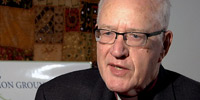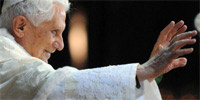In This Episode << SLIDE LEFT TO SEE ADDITIONAL SEGMENTS
The New Anglicanism?
 |
by J. Peter Pham
Anglican Communion in Crisis: How Episcopal Dissidents and Their African Allies Are Reshaping Anglicanism. By Miranda K. Hassett. Princeton University Press, 2007.
The bishops and other leaders gathering this month in Canterbury for the fourteenth Lambeth Conference will be considering the future of the Anglican Communion. The last meeting ten years ago is best remembered for the major role which the bishops from the “global South” played, especially in the 526-70 (with 45 abstentions) passage of a resolution upholding as the “teaching of Scripture” the ideal of “faithfulness in marriage is between a man and a woman in a lifelong union” and abstinence “for those not called to marriage” as well as “rejecting homosexual practice as incompatible with Scripture,” while calling for pastoral ministry and sensitivity to “persons who experience themselves as having a homosexual orientation.”
Far from putting the matter to rest, the tensions raised during the often acrimonious debate leading to the declaration have only been exacerbated over the course of the ensuing decade. In fact, nearly one-quarter of the more than 800 bishops invited are snubbing this year’s conference in protest over the presence of prelates whom they accuse of sanctioning same-sex unions and ordaining non-celibate gay and lesbian clergy. In June, the boycotters held a separate summit in Jerusalem, the Global Anglican Future Conference (GAFCON), where they were also joined by sympathizers who are nonetheless attending Lambeth.
As Philip Jenkins has argued in his recently completed trilogy of studies, a great deal of this theological contretemps can be explained by the fact that “the center of gravity in the Christian world has shifted inexorably southward, to Africa and Latin America,” where the approach to theological and moral issues is more traditional than in that found among more progressive believers in Europe and North America. Certainly there has been a decisive shift in the demographic center of the Anglican world in the last one hundred years. The fifth Lambeth Conference, which met under Archbishop Randall Davidson in 1908, represented a church 80 percent of whose communicants lived in the British Isles. In fact, the principal concern of that meeting was foreign missions to places like Africa, where less than 1 percent of Anglicans were then to be found. Today, the situation is the reverse: more than 55 percent of the world’s Anglicans live in Africa, while only 33 percent reside in the United Kingdom (the latter figure is somewhat deceptive, however, since, according to the Church of England’s statistics, only about 1 million of the 26 million nominal Anglicans attend church). The U.S. branch of the Anglican Communion, the Episcopal Church, counts some 2 million members, a decline of more than one-third since the 1960s, who account for approximately 3 percent of the worldwide body. In fact, just between themselves, five of the archbishops not present in Canterbury–the primates of the Anglican churches of Nigeria, Uganda, Kenya, Rwanda, and the Southern Cone of the Americas–represent nearly one-half the Anglicans in the world.
As simple and elegant as this demographic explanation is, it did not completely satisfy Miranda K. Hassett, who made the tensions in Anglican family the subject of her research as a graduate student in anthropology at the University of North Carolina. Anglican Communion in Crisis is distilled from her 2004 doctoral dissertation. Hassett has a personal stake in the object of her study: not only is she admirably forthright in disclosing that her “personal sympathies were with the liberal side,” but she was recently ordained a transitional deacon by the Episcopal Diocese of North Carolina and has taken up the position of assistant rectors at a parish in the Diocese of New Hampshire, a jurisdiction whose choice of a gay man living in a partnered relationship, V. Gene Robinson, as its bishop in 2003 her own book notes “drew an intense outcry from Anglican leaders around the world” and led several Anglican provinces to downgrade relations with the Episcopal Church. These factors render all the more laudable Hassett’s treatment of the subject which, within its limits, is generally balanced and, unlike many other recent works, free from rancor. The volume’s subtitle–How Episcopal Dissidents and Their African Allies Are Reshaping Anglicanism–hints at her conclusion: “The Episcopal Church’s [conservative] dissidents and their Southern allies are not merely carried along by global trends, but have actively shaped the character and impact of globalization on the Episcopal Church and the Anglican Communion.”
Hassett’s research opens in the period after the 1998 Lambeth Conference and focuses on the transnational alliances which were forged between some seemingly unlikely partners, “American social conservatives, commonly stereotyped as having little interest in including the marginalized, and Southern church leaders, whose demands for greater influence threaten the Northern-dominated status quo.” Her key insight is her appreciation that globalization is not an inexorable and impersonal force, but a dynamic process which can be shaped by human agents. Thus her research included extensive time with a congregation in the southeastern United States she pseudonymously calls “St. Timothy’s,” which had left the Episcopal Church to affiliate with the Anglican Mission in America (AMiA) under the jurisdiction of the Church of the Province of Rwanda, as well as six months in central Africa, where she focused her efforts on the Uganda Christian University, an Anglican university and seminary with close ties to a number of more conservative U.S. parishes and organizations. (In accordance with the conventions of her discipline, Hassett protects the anonymity of her sources. While the discretion, especially in the case of laypeople, is understandable given the nature of some of the issues with which she grapples, it also makes impossible any independent assessment of the ecclesiastical weight to give to pronouncements she attributes to bishops and other prominent church leaders.)
From the narrative of the fieldwork as well as Hassett’s nuanced analysis of her observations, it is clear that she is a dispassionate scholar, willing to challenge widely held stereotypes about conservative Anglicans in both the United States and Africa.
While the members of St. Timothy’s originally joined AMiA as what Hassett describe as “a lifeboat” away from an Episcopal Church they perceived to be increasingly errant in its leftward drift while still maintaining their connection to the larger Anglican Communion through the archbishop of Rwanda, she found that the new relationship had a profound impact on both parish and parishioners that went far beyond canonical formalities to forge “a transnational relationship of significant local meaning.” Describing the congregation’s efforts to “think more seriously about what their connection to Rwanda might mean”–which ranged from a display and sale of African handicrafts to assisting an African priest raising money for AIDS orphans to a trip to visit their new provincial see by several congregants–Hassett notes that the “congregation’s experience of finding an alliance with an African church first thinkable, then desirable, involved more and more members’ coming to see African Christianity as a positive model.” As a result, members of St. Timothy’s “were coming not only to think about Africa in new and positive ways but also to look more critically on their own way of life as Americans.”
If “conservative dissidents point to the orthodoxy, zeal, and other desirable traits they perceive as characterizing the churches of the global South, and seek to bring that moral force to bear in transforming the Episcopal Church,” the Anglicans Hassett encountered in Uganda–the heirs of a colonial church if ever there was one, as Danish Africanist Holger Bernt Hansen’s monumental study Mission, Church, and State in a Colonial Setting: Uganda, 1890-1925, authoritatively documented–have been excited by the discovery that “Africans have something to teach American Christians.” According to Hassett, African Christians see this as an exchange not unlike that of economic globalization whereby “each region is envisioned exporting what it has in plenty, trading those goods for what another region can readily provide”–in this case, spiritual aid in return for material assistance. Consequently, Hassett posits broadly: This collective and individual rethinking demonstrates that globalization, as represented by the transnational Anglican dissident movement, is not simply Westernization, a one-way process in which the Southern partners take on the culture and ideas of Northerners. Instead the people of St. Timothy’s were influenced by their Rwandan allies to adopt new ways of thinking and talking, indicating that such global relationships have effects in both directions. While she cautions conservatives that an idealization of African Christianity “invokes concepts ultimately derived from older and negative views of Africans as childlike, primitive, and uncivilized,” Hassett reserves a stronger criticism for liberals who, long presuming on the solidarity of the developing world due to “the bias toward the Left in the scholarly literature on global movements,” have reacted angrily to the unexpectedly strong doctrinal stances of Southern bishops by describing them as “superstitious, ignorant, and opportunist.” In contrast to scholars like Ian Douglas, subsequently her professor at the Episcopal Divinity School in Cambridge, Massachusetts, as well as a member of the design group for this year’s Lambeth Conference, who propose a vision of globalization which she describes as “diversity globalism”–that is, “characterized by the affirmation of cultural and experiential diversity” and “nothing more clearly defined than general mutual good will”–Hassett writes that conservative Northerners and Southerners have together built various networks into the interconnected structure she labels “accountability globalism”: This is no veiled anti-globalism or reactionary vision, in which older authority structures of white male Euro-American dominance are reestablished to maintain order in an increasingly complex worldwide organization. Instead, this conservative vision embraces the diversity and complexity of the contemporary world…call[ing] for power to shift away from traditional centers and to locate instead in a worldwide network of church leaders united in their commitment to Anglican orthodoxy. New, global patterns of discipline are envisioned in the service of correction, help, and, above all, accountability among Anglican churches around the globe. While Anglicans, like Roman Catholics and Eastern Orthodox Christians, have historically organized their ecclesiastical polities around local bishops whose jurisdiction is largely defined by territorial boundaries, Hassett sees the potential of the nascent affinity networks which are manifestations of accountability globalism to radically transform relationships within the church: [P]articular connections between individuals, parishes, dioceses, and provinces…bypass and even subvert the centralized, nested geographical authority structure of the Communion. It remains to be seen whether the total “realignment” of the Communion into networked clusters of Anglican bodies defined by affinity rather than geographical proximity will come to pass…Today many believe that such networks will become, functionally if not officially, the new organizing structure of the whole Anglican Communion. Certainly there have been moves towards such realignments across the Anglican world. In the last year, the Nigerian, Ugandan, and Kenyan provinces have followed the Rwandan province in consecrating “missionary bishops” for work in the United States. More recently, the bishop and diocesan convention of the Diocese of San Joaquin, California, have voted to align themselves with the South America-based Province of the Southern Cone, and other Episcopal dioceses are reported to be considering “exit strategies.” And while strategic partnerships between Northern conservatives and Southern Anglican leaders and churches have clearly become more common, there is no reason to preclude moderates and liberals within the Communion from creating their own affinity networks. Hassett, for example, chronicles the founding in 2000 of a Ugandan branch of Integrity, an advocacy organization for gay, lesbian, bisexual, and transgender Anglicans, and the subsequent controversy within the province over the involvement of a retired bishop, Christopher Ssenyonjo, as the group’s counselor. The author’s most important contribution might well prove to be her disentangling of this bewildering collection of efferent strands and reweaving them into a comprehensible narrative heralding one vision of how today’s feuds might eventually be resolved.
As an academic work, Anglican Communion in Crisis is not without its share of problems. For example, while differing attitudes about homosexuals has certainly received a great deal of media attention, is it really “the defining issue in contemporary Episcopal Church (and, arguably, Anglican Communion) conflicts” that Hassett characterizes it as? A credible case can be made that the fault lines run much deeper into clashes over fundamentals of faith and that the controversy over homosexuality is perhaps better understood oftentimes as a proxy used by some on both sides of the revisionist/traditionalist divide. Despite serious efforts to “struggle against [her] eagerness to offer [her] own solutions or conclusions” and to “avoid adjudicating in matters of debate,” Hassett occasionally lapses into making assertions which are at the very least methodologically weak, undocumented, and possibly even inaccurate. To cite one case, since she correctly reports that most Episcopalians “are not particularly mobilized on the issue of gay rights” and that “public, outspoken activism for the full inclusion of gay, lesbian, bisexual, and transgender (GLBT) Episcopalians in the church is largely limited to the leaders of the Episcopal GLBT rights group, Integrity, and a few outspoken bishops, other church leaders, and scholars,” as a matter of social science how can she then claim that “the mobilized liberal camp represents a position with general support of a majority of Episcopalians” in the absence of any reference to survey data supporting that conclusion? Also, the book is bogged down at times in a tendentious disputation with certain conclusions in Philip Jenkins’s The Next Christendom, a conceit all the more disappointing since Hassett does not appear to have taken into account any of the subsequent work by the Distinguished Professor of History and Religious Studies at Pennsylvania State University that would have obviated a substantial part of the critique.
Notwithstanding these shortcomings and the fact, modestly acknowledged by the author, that its “account of current debates in the Anglican tradition is contestable,” Anglican Communion in Crisis is a must-read, not only by those most directly involved in what are, frankly, often unseemly fracases within the Anglican body politic–especially the mitered heads at Lambeth (as well as GAFCON) who are called, in the words of the Book of Common Prayer, “for the work and ministry of a bishop…the edifying and well-governing of the Church”–but also by anyone interested in the future of Christianity as a whole amidst constantly shifting global dynamics.
J. Peter Pham, director of the Nelson Institute for International and Public Affairs at James Madison University in Virginia, is the author of many works on religion, international affairs, and African politics. An ordained priest of the Episcopal Diocese of Quincy, he has written for Religion & Ethics NewsWeekly on books by Pope Benedict XVI and Philip Jenkins.







